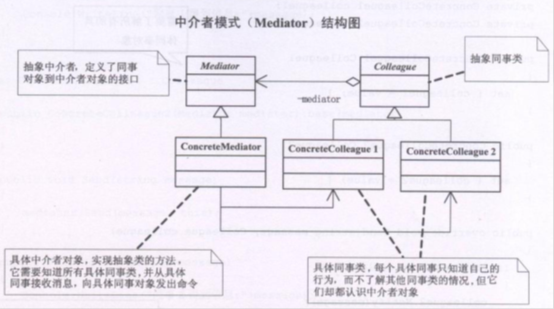概念
Mediator模式也叫中介者模式,是由GoF提出的23种软件设计模式的一种。Mediator模式是行为模式之一,在Mediator模式中,类之间的交互行为被统一放在Mediator的对象中,对象通过Mediator对象同其他对象交互,Mediator对象起着控制器的作用。
角色和职责
GOOD:用一个中介对象来封装一系列的对象交互,中介者使各对象不需要显示的相互引用,从而降低耦合;而且可以独立地改变它们之间的交互。

Mediator抽象中介者
中介者类的抽象父类。
concreteMediator
具体的中介者类。
Colleague
关联类的抽象父类。
concreteColleague
具体的关联类。
适用于:
用一个中介对象,封装一些列对象(同事)的交换,中介者是各个对象不需要显示的相互作用,从而实现了耦合松散,而且可以独立的改变他们之间的交换。
模式优点
1,将系统按功能分割成更小的对象,符合类的最小设计原则
2,对关联对象的集中控制
3,减小类的耦合程度,明确类之间的相互关系:当类之间的关系过于复杂时,其中任何一个类的修改都会影响到其他类,不符合类的设计的开闭原则
,而Mediator模式将原来相互依存的多对多的类之间的关系简化为Mediator控制类与其他关联类的一对多的关系,当其中一个类修改时,可以对其他关联类不产生影响(即使有修改,也集中在Mediator控制类)。
4,有利于提高类的重用性
案例
//模拟婚配,正常类的使用
#include <iostream>
using namespace std;
#include "string"
class Person
{
public:
Person(string name, int sex, int condit)
{
m_name = name;
m_sex = sex;
m_condition = condit;
}
string getName()
{
return m_name;
}
int getSex()
{
return m_sex;
}
int getCondit()
{
return m_condition;
}
virtual void getParter(Person *p) = 0;
protected:
string m_name; //
int m_sex; //1男 2女
int m_condition; //123456789;
};
class Man : public Person
{
public:
Man(string name, int sex, int condit):Person(name, sex, condit)
{
;
}
virtual void getParter(Person *p)
{
if (this->getSex() == p->getSex())
{
cout << "No No No 我不是同性恋" << endl;
}
if (this->getCondit() == p->getCondit())
{
cout << this->getName() << " 和 " << p->getName() << "绝配" << endl;
}
else
{
cout << this->getName() << " 和 " << p->getName() << "不配" << endl;
}
}
protected:
};
class Woman : public Person
{
public:
Woman(string name, int sex, int condit):Person(name, sex, condit)
{
;
}
virtual void getParter(Person *p)
{
if (this->getSex() == p->getSex())
{
cout << "No No No 我不是同性恋" << endl;
}
if (this->getCondit() == p->getCondit())
{
cout << this->getName() << " 和 " << p->getName() << "绝配" << endl;
}
else
{
cout << this->getName() << " 和 " << p->getName() << "不配" << endl;
}
}
protected:
};
//以上 Woman Man类的太紧密 需要解耦合
void main1901()
{
Woman *w1 = new Woman("小芳", 2, 4);
Man *m1 = new Man("张三", 1, 3);
Man *m2 = new Man("李四", 1, 4);
w1->getParter(m1);
w1->getParter(m2);
delete w1;
delete m1;
delete m2;
return ;
}
void main()
{
main1901(); //问题的引出
system("pause");
}
//改善,使用中介者模式后
class Mediator ;
class Person2
{
public:
Person2(string name, int sex, int condition, Mediator *m)
{
m_name = name;
m_sex = sex;
m_condition = condition;
m_m = m;
}
string getName()
{
return m_name;
}
int getSex()
{
return m_sex;
}
int getCondit()
{
return m_condition;
}
Mediator *getMediator()
{
return m_m;
}
public:
virtual void getParter(Person2 *p) = 0;
protected:
string m_name; //
int m_sex; //1男 2女
int m_condition; //123456789;
Mediator *m_m;
};
class Mediator
{
public:
Mediator()
{
pMan = NULL;
pWoman = NULL;
}
void setWoman(Person2 *p)
{
pWoman = p;
}
void setMan(Person2 *p)
{
pMan = p;
}
void getPartner()
{
if (pMan->getSex() == pWoman->getSex())
{
cout << "No No No 我不是同性恋" << endl;
}
if (pMan->getCondit() == pWoman->getCondit())
{
cout << pMan->getName() << " 和 " << pWoman->getName() << "绝配" << endl;
}
else
{
cout << pMan->getName() << " 和 " << pWoman->getName() << "不配" << endl;
}
}
protected:
private:
Person2 *pMan;
Person2 *pWoman;
};
class Woman2 : public Person2
{
public:
Woman2(string name, int sex, int condition, Mediator *m) : Person2(name, sex, condition, m)
{
;
}
virtual void getParter(Person2 *p)
{
this->getMediator()->setWoman(this);
this->getMediator()->setMan(p);
this->getMediator()->getPartner();
}
private:
};
class Man2 : public Person2
{
public:
Man2(string name, int sex, int condition, Mediator *m) : Person2(name, sex, condition, m)
{
;
}
virtual void getParter(Person2 *p)
{
this->getMediator()->setMan(this);
this->getMediator()->setWoman(p);
this->getMediator()->getPartner();
}
private:
};
void main1902()
{
Mediator *mediator = new Mediator;
Woman2 *w1 = new Woman2("小芳", 2, 4, mediator);
Man2 *m1 = new Man2("张三", 1, 3, mediator);
Man2 *m2 = new Man2("李四", 1, 4, mediator);
w1->getParter(m1);
w1->getParter(m2);
delete w1;
delete m1;
delete m2;
delete mediator;
}
void main()
{
main1902(); //用中介者模式 进行优化
system("pause");
}